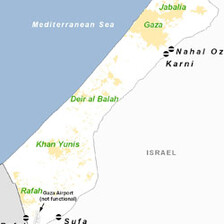The Electronic Intifada 19 January 2009
RAMALLAH (IPS) - Humanitarian aid is being rushed into Gaza as Israel and Egypt open their borders temporarily to allow convoys of aid to pass through.
While Israeli drones circle the skies above, Hamas security men are back on the streets attempting to restore some semblance of law and order. Policemen are directing traffic. Several looters have been arrested.
Gazans who survived the battering inflicted by Israel’s 22-day military campaign, codenamed Operation Cast Lead, are venturing out and trying to pick up the pieces of their lives.
“People are feeling dazed and confused. Many are desperately trying to contact family members and friends on the few remaining phone lines that operate to see if they are still alive or if they are injured,” Abdallah al-Agha from Khan Younis in the south of Gaza told IPS.
“Others are leaving UN shelters for the first time in days to see if and what remains of their homes,” added al-Agha.
Elena Qleibo, a Gaza-based aid worker from Oxfam and an ex-Costa Rican ambassador to Israel, said parts of Gaza resembled an apocalypse.
“The destruction wrought on Beit Lahiya, in northern Gaza, and the Zeitoun suburb in eastern Gaza city is immense,” Qleibo told IPS. “The sewage is flowing in the streets. Electricity pylons, water and sewage works, municipal and medical buildings, and homes have been leveled.”
Initial estimates state that 15 percent or 20,000 of the Gaza Strip’s buildings have been damaged, with nearly 30,000 Palestinians forced to find shelter in the UN agency for Palestine refugees (UNRWA) shelters and with family.
Nearly 1,300 Gazans lost their lives, around a third of these children, with a total of more than half of the deaths civilian. The number of injured is pushing 4,000.
“People are extremely angry and the level of hate against Israel is very high. I have lived and worked in Gaza for many years and I have never seen such hatred from the population,” said Qleibo.
Gazans are not blaming Hamas, contrary to Israel’s wishes. “People laugh at Israel’s claims that this was a war against the Islamic resistance organization and not one aimed at civilians.”
“They see this as a war against all Palestinians. The number of civilians killed and maimed and the destruction wrought was way too extreme,” said Qleibo.
“The scale of death and destruction is most definitely counter-productive. Throughout this conflict so many experts and global leaders have highlighted there is no military solution to this conflict — an effective political solution is needed,” John Ging, the head of Gaza’s UNRWA, told Maan News Agency.
UNRWA’s main compound in Gaza City, which feeds 750,000 Gazan refugees, half of the total population, was destroyed in an Israeli attack 15 January.
Ging said that 50 aid trucks entered Gaza Saturday, the day Israel announced its unilateral ceasefire.
“But we need hundreds of trucks. The needs are growing exponentially and the pipeline for humanitarian supplies is very narrow. Even those, such as Palestinian Authority (PA) employees, who were not dependent on UNRWA assistance, have become dependent. There is nothing on the market and there is no cash,” Ging told Maan.
“We cannot contemplate that the crossings will remain closed; there must be a better future. The ordinary people here during this siege have paid the price of this conflict and this operation. For them, their singular priority is access to restore dignity to their existence.”
“The closures have driven thousands into aid dependency against their will — that has to end. A solution that prioritizes the needs of the ordinary people must be found,” said Ging.
Egypt allowed 42 seriously injured Gazans to pass through the Rafah crossing in the south to travel to Egyptian hospitals. Tons of international medical supplies and three ambulances from Qatar entered Gaza from Rafah. Forty-nine doctors from abroad are supplementing exhausted teams of Palestinian medical staff at Gaza’s main hospitals.
In addition to medical supplies, 401 tons of food donated by Libya, Morocco, Oman and Jordan entered Gaza from Egypt. Ninety tons of food entered Gaza from an Israeli crossing point.
Egyptian civil society organizations donated nearly 12,000 blankets to replace those destroyed during Israel’s attack on the UN warehouse.
“While international food and medical aid is desperately needed, it is also imperative that in the longer run urgent socio-psychological treatment is extended to a severely traumatized civilian population,” Qleibo told IPS.
Meanwhile, rescue teams are pulling out bodies from underneath mountains of rubble, something Israeli soldiers stationed in the area previously prevented. Once all bodies are recovered, the death toll may rise significantly.
Muawiyah Hassanain, director of Ambulance and Emergency Services in the Health Ministry in Gaza, said that dozens of bodies were extricated on Sunday alone.
The full scale of the horror is yet to be revealed as the international foreign corps based in Israel continues to fight for unrestricted access into Gaza to report first-hand. Israel has enforced a ban for close on two months on all media other than a few handpicked reporters embedded with Israeli forces, who were permitted entry.
“Professionals should be allowed into the battlefield,” said Foreign Press Association secretary Glenys Sugarman, unimpressed by the reporters the Israeli army spokesperson’s unit let in.
“You can’t just send journalists to join the military forces who show them around. That is not independent and open reporting. In the modern, open world, when there are people that see and are willing to comprehend what’s going on here — this is an important message,” added Sugarman.
All rights reserved, IPS - Inter Press Service (2009). Total or partial publication, retransmission or sale forbidden. Jim Lobe in Washington contributed to this article.
Related Links





